Owners of instantaneous water heaters do not need a protective valve (flow valve), but storage water heaters (and they are the majority in the country) without a valve will not even be accepted for warranty service!
Why is a safety valve for a boiler so necessary and what is this part? How to select and install it? Let's figure it out together.
A storage water heater is a sealed container that contains a constant volume of liquid. Usually, when a person has used up some of the hot water, it is replaced with cold water. The problem arises when no one uses the water, but heating continues.
As you know, when water reaches temperature 90 0 C, it expands by 3%. This means that in a 60-liter boiler there will be almost 2 liters of “extra” liquid, which will have nowhere to go if a valve is not installed! This situation will lead to an accident.
But the functions of the safety valve do not end with accident insurance. 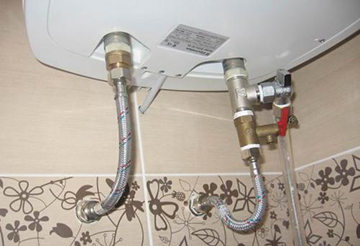
It is also needed:
- To prevent warm water from returning from the tank to the water supply;
- To prevent water hammer (smoothes inlet pressure);
- It was possible to drain the water from the heater during repairs.
- If the water supply is completely turned off, you will not have to refill the boiler.
Don't rely only on thermostats. They control the degree of heating of the water and prevent it from boiling. But like any other device, they sometimes malfunction. The consequences of such a breakdown are too dangerous to risk.
Design and principle of operation
Externally, the safety valve for a water heater consists of two brass cylinders, one of which is docked to the side of the other. The larger cylinder is a poppet valve (also known as a check valve for a water heater); it ensures that liquid flows in one direction and prevents it from flowing in the opposite direction. There are threads on both ends of this part to connect the valve to the boiler and pipes.
A blast valve (also known as a direct-acting spring) is placed perpendicularly. It is plugged from the outside, and on the side there is a small pipe for draining water. Inside it is a valve with the opposite direction of operation.
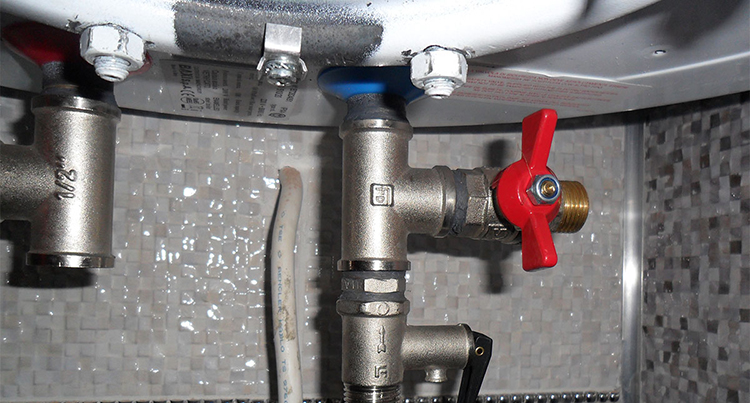
Installed safety valve for boiler
While the pressure is normal, the valve is “closed” and does not allow fluid to escape out. This is ensured by spring pressure. But when the water pressure exceeds the force of the spring, it opens and releases the excess water. Often there is a handle on the valves for forced drainage of water (when the owner needs to empty the water heater).
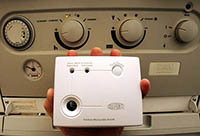 Did you know that a gas boiler can be controlled manually or automatically? : What are the differences between volatile and non-volatile systems? Functions and types of gas valves.
Did you know that a gas boiler can be controlled manually or automatically? : What are the differences between volatile and non-volatile systems? Functions and types of gas valves.
Read about what malfunctions can occur with Navien boilers and how to fix them.
If your water is heated using a gas water heater, you have probably encountered the following problem - the gas boiler goes out. Here you will learn why this happens and how to troubleshoot.
Why might water drip from a part?
This indicates that the part is working properly. But, even if the process is too active and causes concern to the owner, there is no need to panic.It could be:
- The spring stiffness is incorrectly set.
- The pressure in the pipeline is too high.
The first reason could arise from interference in the settings by non-professionals. The fact is that many valves are made with the ability to change the factory settings for spring stiffness.
A specialist must set the hardness correctly. If the settings have not been changed, perhaps the spring has weakened, then it is better to change it to a new one.
When the cause is pressure surges in the pipeline, it would be good to install a pressure reducing valve before the safety valve.
If the water supply pressure is excessive, you can install a pressure reducing valve at the entrance to the apartment and protect all devices at once.
Why water never drips from the boiler safety valve
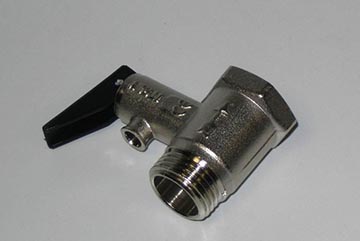 The fact that water never drips from the valve, even when the boiler is heated to maximum, should greatly alert its owner.
The fact that water never drips from the valve, even when the boiler is heated to maximum, should greatly alert its owner.
Most likely, it is faulty, clogged, jammed, or was immediately selected incorrectly.
It’s not worth the risk - it’s better to change it right away! However, another reason for a “dry” valve can be a simply leaking hot water faucet.
It turns out that he is constantly “dumping” water. It's not scary, but it's not economical - electricity bills flow down the drain.
Is it possible to replace the safety valve with a non-return valve?
No! Absolutely not! When a check valve is installed instead of a safety valve, the following situation is quite possible (if the thermostat fails): the heating element brings the water to a boil, the pressure increases. If the pressure is 10 atm. water boiling point = 180 0 C. And the higher, the more.
Let's assume the boiler survived all this. But someone will open a tap or a faucet hose will burst. The pressure inside will immediately drop, the boiling point will drop to 100 0 C, but it is already heated up much more! There will be an instant boiling of the entire mass, the release of steam and, as a result, an explosion.
Instructions: how to check if the safety valve for a water heater is working
For a visual inspection, you need to turn on the boiler at full power and monitor. If the device is working properly, it will start to drip.To always see whether the safety valve is working, it will be convenient to install a transparent hose at the drainage outlet (it can be led into a sewer or container).
A forced drain handle (lever) is also useful. After all, the inlet hole can become clogged with rust and other impurities.
To ensure that the valve is still leaking water, you should manually drain a small amount of fluid periodically.
Choice
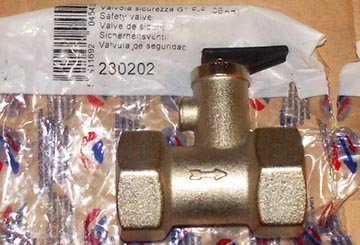 When buying a safety valve for a water heater, you need to pay attention to the following:
When buying a safety valve for a water heater, you need to pay attention to the following:
- what temperature is it designed for;
- for threaded connections (most often ½ inch);
- on pressure;
- Is there such a useful attribute as a handle for forced draining?
Valve pressure is an indicator that must be clarified when purchasing! If you buy a device with a smaller value, water will flow from the valve all the time. If it is larger, it may be useless and not protect against a boiler explosion.
Installation
Reputable manufacturers produce heaters with a safety valve.
If you need to install the valve yourself, then:
- The boiler is turned off and the water is drained from it.
- The valve is installed on the supply pipe (i.e. on the cold water pipe).
- The installation process itself is the most common: use a 3-4 turn key with FUM tape or tow.
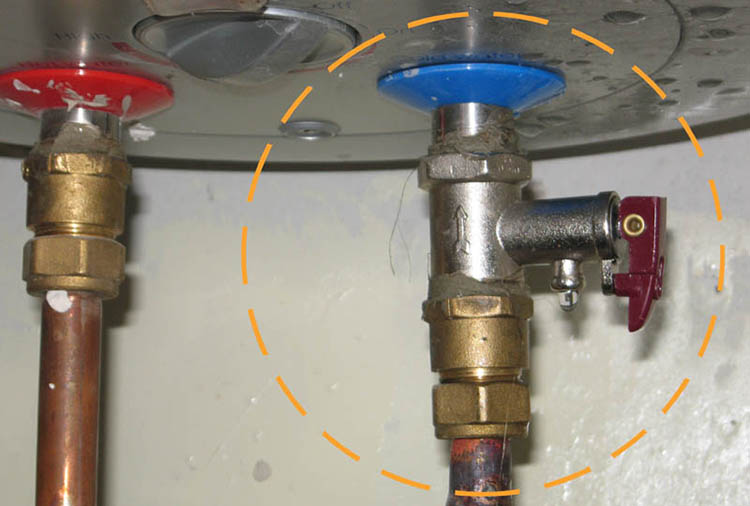
Safety valve installed on the boiler
Be sure to orient the valve correctly. The direction of flow must coincide with the arrow on the body.
So. The safety valve for a water heater is the same “spool” that is small but expensive! Simple design, low price (only about 200-400 rubles), but with it you don’t have to worry that the heater will fail or even explode. Not scary, but water outages and pressure surges in the water supply.